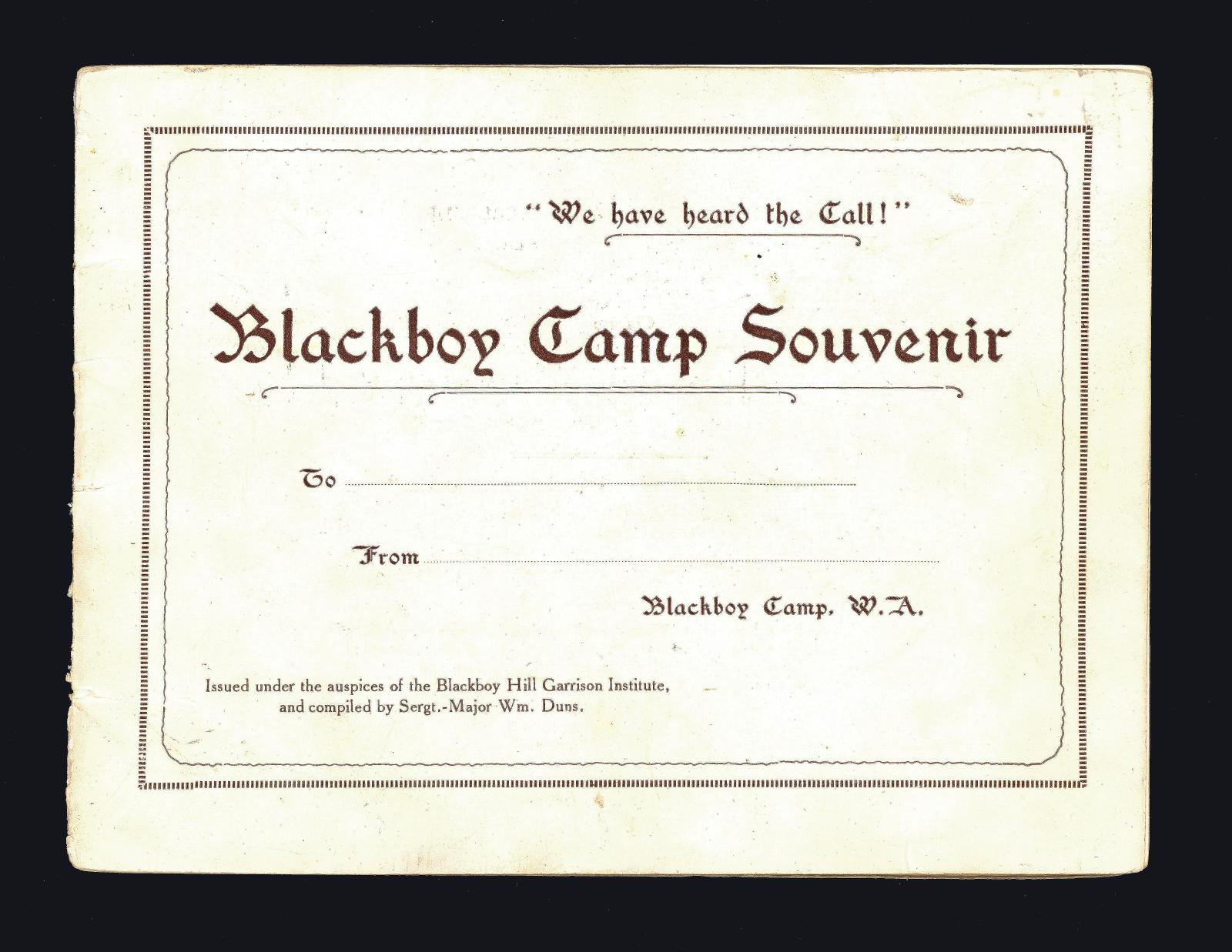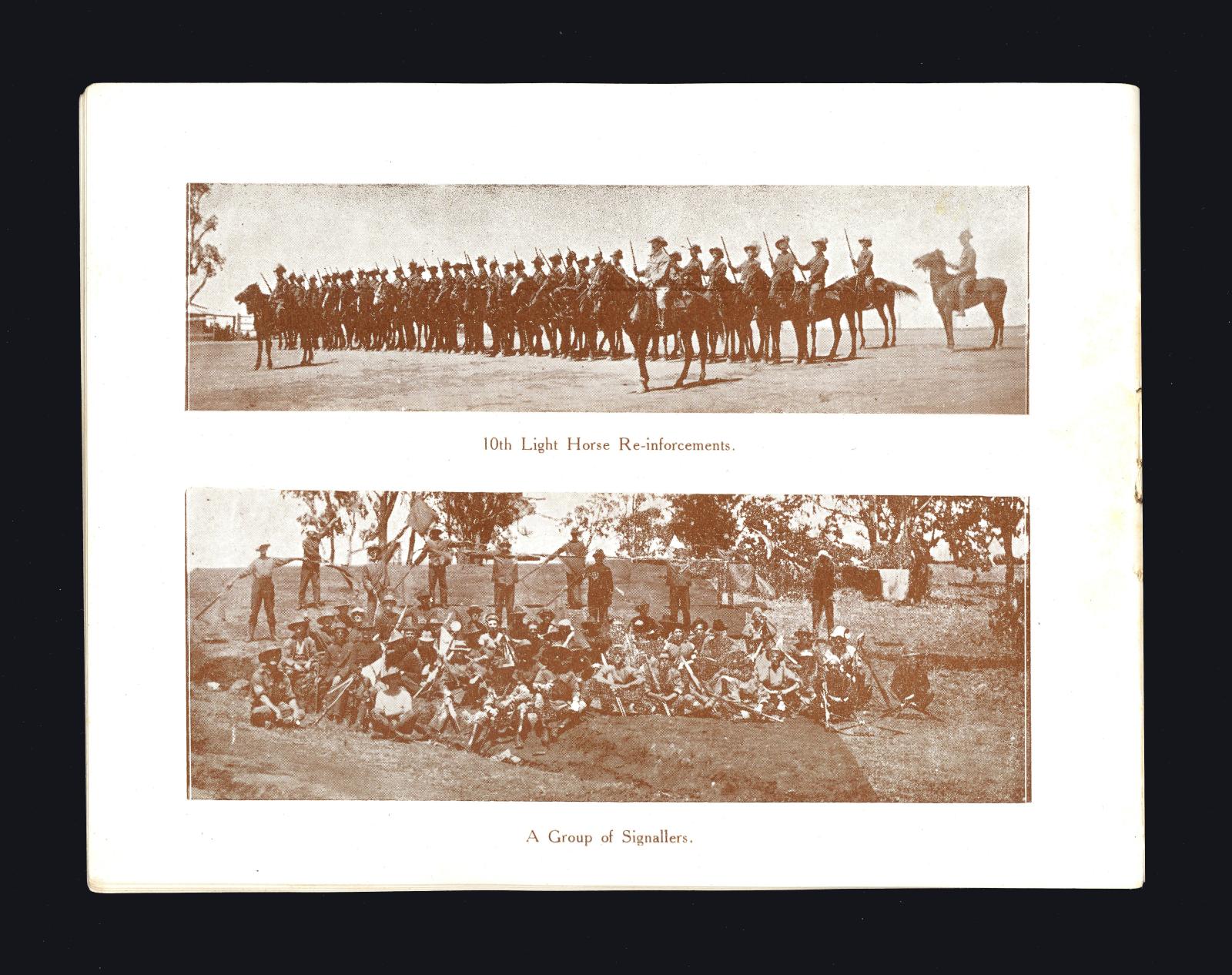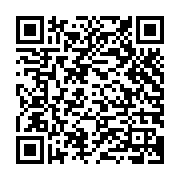SOUVENIR BOOKLET BLACKBOY CAMP
c. 1916Rectangle cream paper booklet, spine of book sewn in place. Brown text on front ["We have heard the Call!" / Blackboy Camp Souvenir / To / From / Blackboy Camp, W.A. / Issued under the auspices of the Blackboy Hill Garrison Institute, / and compiled by Sergt-Major Wm. Duns.]. There are dotted lines following the words To and From for owner of book to write on.
On the back is a illustrated cartoon titled at the bottom ["WON'T YOU COME AND HELP US?"]. Cartoon is of a man in uniform holding a rifle with bayonet in left hand with his right hand raised up. Boulders behind him with a figure holding a rifle to his left and a pair of legs with gaiters and boots by his feet. Printing information under the cartoon.
Inside the booklet are photographs and text relating to the Blackboy Hill camp and the soldiers training there.
The souvenir book belong to the Serls family of Bedfordale. It would have been collected in 1916 when Earnest William Serls entered Blackboy Hill camp for his military training. Blackboy Hill camp, at the foot of the Darling Ranges was open on 17 August 1917, 12 days after the declaration of war. Over 32,000 Western Australian soldiers completed their basic training at the camp before leaving for war.
Ernest Serls, aged 26, from Bedfordale enlisted in the AIF on 5 April 1916. A month late on 4 May he entered Blackboy Hill camp for his training. On 20 June 1916 he was posted to the 4th reinforcement group for the 44th Battalion. He embarked for Europe aboard HMAT Port Macquarie on 13 October, joining the 44th Battalion on 6 February 1917 in Belgium. On 4 October 1917 during the Battle of Broodseinde, Ernest was killed by an explosive shell. He is buried at Tyne Cot Cemetery in Belgium.
This souvenir booklet was produced in c1915 as something to give family members showing them what the camp looked like and what the soldier would have done at the camp. This book would have been one of the last things given to the Serls family by Ernest before he embarked for Europe, where on 4 October 1917 he was killed in action.
The book also features cartoons by prominent Western Australian cartoonist Ben Strange. Ben Strange was a strong supporter of Australia's involvement in the war and his cartoon in the book is a call to Australia to send their support and soldiers to support the soldier already fighting in Europe.
The Ben Strange cartoons are historically significant as they depict many key figures linked to the history and development of both Western Australia and Australia. Political figures who regularly appeared in his cartoon’s included John ‘Happy Jack’ Scaddan, the Premier of Western Australia from 1911 until 1916, and William ‘Billy’ Hughes, the Prime Minister of Australia from 1915 to 1923.
With the outbreak of World War One Stranges’ focus broadened to include international political commentary as he keenly observed the conflict. The cartoons from this period provide insight into public opinion regarding the war. However, Strange did not neglect domestic matters, drawing cartoons concerned with wide-ranging issues including: the economic and social cost of gambling; taxation; Government debt; declining population; the White Australia Policy; shop lifting; and the campaign to introduce Western Australia’s first female officers. Therefore, the collection has particular associations with an evolving cultural identity, as well as significant local appeal.
The cartoons have high artistic significance due to the quality of execution. Ben Strange was a self-taught artist who had a knack for concisely encapsulating and commenting on the events of the day within his illustrations. His work was well regarded in the period, evidenced by his frequent inclusion in the English ‘Review of Reviews’. No other similar set of original drawings exists by this artist, or indeed by any other Australian cartoonist working within this period. The number and quality of these works adds considerably to the collection’s importance.
The cartoons are well provenance, as Strange created the cartoons for the Western Australian readership of the Western Mail from 1898 till his death in 1930. The cartoons in particular provide unique insight into not only Strange’s views on issues of local and national importance, but by extension, contemporary opinion on the issues of the day. The original cartoons were collected by Ivor T. Birtwistle, who worked at the Western Mail from the age of 15 as a copy-boy, and went on to become Editor of the paper in 1924.
BIBLIOGRAPHY
Australian Cartoon Museum, ‘Political’, ACM: An Online Museum for Australian Cartoons [website], http://www.theaustraliancartoonmuseum.com.au/category/cartoons/political/, accessed 6 July 2017.
Bolton, G.C. ‘Strange, Benjamin Edward (Ben) (1868-1930)’, Australian Dictionary of Biography [website], National Centre of Biography, Australian National University, http://adb.anu.edu.au/biography/strange-benjamin-edward-ben-8695/text15213 , published first in hardcopy 1990, accessed 11 July 2017.
National Gallery of Victoria, ‘Collection’, NGV [website], 2015, https://www.ngv.vic.gov.au/?type=collection&s=political+cartoons, accessed 11 July 2017.
National Museum of Australia, ‘Collection Explorer’, NMA [website], http://collectionsearch.nma.gov.au/, accessed 6 July 2017.
Museum of Sydney, ‘Research & Collections’, Sydney Living Museums [website], https://sydneylivingmuseums.com.au/search/node/political%20cartoons, accessed 6 July 2017.
Museum Victoria, ‘Collections’, Museums Victoria [website], https://collections.museumvictoria.com.au/search?query=political+cartoons, accessed 6 July 2017.
Western Australian Museum, ‘Western Australian Museum Online Collections’, Western Australian Museum [website], 2017, http://museum.wa.gov.au/online-collections/search/site/political%20cartoons, accessed 11 July 2017.





